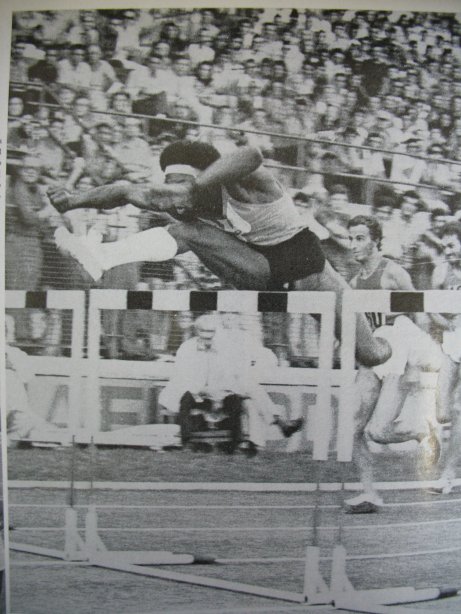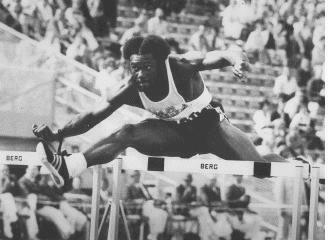 As I continue to gather research for the biography I plan to write on 1972 Olympic high hurdle champion Rodney Milburn, I find that the thing that most intrigued me about his hurdling technique was his employment of a double-arm motion during hurdle clearance. Both his lead arm and his trail arm would thrust forward, bent at the elbows, as he dove into the hurdle. Although this style of hurdling is considered archaic by today’s standards, it enabled Milburn to become the most dominant hurdler of his era, and one of the greatest hurdlers ever. This article will discuss the benefits and drawbacks of the double-arm motion, and whether or not this technical innovation could still be considered useful to a hurdler in the modern era.
As I continue to gather research for the biography I plan to write on 1972 Olympic high hurdle champion Rodney Milburn, I find that the thing that most intrigued me about his hurdling technique was his employment of a double-arm motion during hurdle clearance. Both his lead arm and his trail arm would thrust forward, bent at the elbows, as he dove into the hurdle. Although this style of hurdling is considered archaic by today’s standards, it enabled Milburn to become the most dominant hurdler of his era, and one of the greatest hurdlers ever. This article will discuss the benefits and drawbacks of the double-arm motion, and whether or not this technical innovation could still be considered useful to a hurdler in the modern era.
The double-arm motion is apparently something that Milburn created on his own, during solitary practice sessions at J.S. Clark High School in Opelousas, LA, and with the help of his coach, Claude Paxton. As Leon Coleman, 4th-place finisher in the 110 meter hurdles at the 1968 Olympics in Mexico City explained, the specific purpose of the double-arm motion was to make sure that Milburn’s trail arm did not swing back too far, which was causing him to spend too much time in the air. Coleman, who now coaches at Mississippi Valley State University, pointed out that by bringing the trail arm forward, with the lead arm, Milburn was ensuring that all of his weight was going into the hurdle, with minimal lateral movement or pausing on top of the hurdle.
When Milburn was still a high-schooler, Paxton, successfully experimented with what was later termed “the dime method” of hurdling. Paxton would place a dime on top of each crossbar and instruct Milburn to knock off the dimes as he cleared the hurdles, but to not touch the hurdles themselves. By mastering this method of hurdling, Milburn was able to “skim” the barriers quite fluidly. He is commonly considered to be the first hurdler to truly sprint over the hurdles on a consistent basis, as opposed to taking three steps and then jumping. The many hours he spent perfecting the dime method, in addition to his natural speed and power, explain his ability to do this. The problem, however, with this method of hurdling, is that it called for the foot of the lead leg to lead the way, not the knee. Therefore, the lead leg knee would lock momentarily during hurdle clearance, and then unlock on the way down. Because Milburn was so fast and powerful, he was able to get away with this flaw without it causing him much of a problem. Renaldo Nehemiah, who followed in Milburn’s footsteps and eventually brought the world record all the way down to 12.93, made the following observation:
“Rod was a freak of nature in regards to speed and explosiveness, so he could get away with using the double-arm the way he did.” Nehemiah expanded on Milburn’s influence upon him by stating, “Rod was the first person [my high school coach] Jean [Poquette] and I ever saw who could sprint off the top of the hurdle. We were fascinated by that. What was he doing to allow himself to do that? That’s what we wanted to figure out. The double-arm had a lot to do with that. And he had a lot of explosion. He was the first hurdler ever to sprint between the hurdles, not just three steps and a jump. That’s all we worked on – getting the body to move continuously, making hurdling as close to sprinting as possible.”
In The Hurdler’s Bible, legendary hurdling coach Wilbur Ross contends that Milburn’s arm carriage prevented him from running under the magical 13.0 barrier. “Rodney carried his arm much too high . . . which shifted his weight momentarily to the rear on the descent side of the flight. If Rodney had used his [lead] arm to create more torque during the pitch phase, he would have produced an optimum aerodynamic recover position on the downward part of the flight” (p. 94). Ross goes on to say that “When athletes carry their arms too high over the center of mass, they interrupt the flow of their forward momentum. . . . I believe Rod could’ve run under 13.0 electronically if his arms were rotated left over right (lead leg) and the [trail] arm was moved to the rear of his body while he was in flight (p. 94). Putting the technical jargon aside, the point Ross was making was that Milburn’s habit of carrying his arms so high caused him to spend more time in the air, as opposed to the more efficient style keeping the lead arm low and pulling the trail arm straight back, with the elbow bent.
Poquette, however, observes that Milburn didn’t really bring his arms as high as he appeared to. Because he dove into the hurdle, and brought his head down very low, it seemed that the arms were raised high when in fact they were staying level. As Poquette said, “Guys who dive [into the hurdle] bring their head down under the [lead] arm. The purpose of the double-arm was to assist in the dive. We didn’t want to dive.” Nehemiah says that, at first, he did use a modified version of the double-arm before weaning himself away from it altogether. “As you get older, stronger, and faster,” he explained, “the double-arm would cause more hesitation, a longer wait, as parts of the body aren’t moving. So what we did to modify it was, we would initiate the double-arm, but we wouldn’t hold it there. We would kind of use it as an open-the-door kind of thing. [As a right-leg lead], the right arm was initially for balance, but I didn’t have to keep that wing out there, so we brought that arm back. We started realizing that it would be faster if both arms were moving simultaneously. By my sophomore year of college, I figured out that I didn’t have to stay as long with the double-arm.”
 One of the primary criticisms of the double-arm technique – and probably the one that caused it to fade from common usage – is that it causes balance issues. Both arms thrusting forward at the same time “will get you rotating to the lead-leg side,” Poquette remarked. As a result, the natural movement of sprinting is compromised, as is fluidity, and there is also the danger of stumbling upon landing when all the weight is pressing down on one side of the body. Nevertheless, when considering Milburn’s enormous success using the double-arm technique, there had to be something unique about it that made it work. Charles Foster, who battled against Milburn throughout the early to mid 1970’s and now coaches the sprinters and hurdlers at Clemson University, offers the following insights:
One of the primary criticisms of the double-arm technique – and probably the one that caused it to fade from common usage – is that it causes balance issues. Both arms thrusting forward at the same time “will get you rotating to the lead-leg side,” Poquette remarked. As a result, the natural movement of sprinting is compromised, as is fluidity, and there is also the danger of stumbling upon landing when all the weight is pressing down on one side of the body. Nevertheless, when considering Milburn’s enormous success using the double-arm technique, there had to be something unique about it that made it work. Charles Foster, who battled against Milburn throughout the early to mid 1970’s and now coaches the sprinters and hurdlers at Clemson University, offers the following insights:
“I used the double arm as well. The double arm seemed to pan out, but I would say it would probably be beneficial even now. Because you have one elongated stride every four steps, that first step is the elongated stride that carries you over the hurdle. To achieve the maximum thrust, you want everything going forward; you really don’t want equilibrium. You change [your center of gravity] and make the power move, and that pushes you along to the next hurdle. With one arm forward, one arm back, there’s certainly gonna be some flight time when you don’t have thrust forward. You’re gonna have a natural movement, but no thrust. A natural movement for someone like [two-time Olympic silver medallist] Terrence Trammell is gonna be fast, because he runs a 10.1 hundred. But if you’re running 10.7, you could benefit from the double-arm.”
Foster’s explanation goes a long way toward answering the question of how Milburn was able to accelerate so well when landing off each hurdle, and to pull away from his competitors seemingly at will. Being the imitative creatures that we are, it seems that the double-arm has faded out of existence because the best hurdlers in the world don’t use it. Still, the points that Foster makes are worth considering. Being a creative coach and a student of the event is all about trying new things, different things, because you never know how a technical adjustment might aid in the development of a particular athlete, even if it doesn’t help others. So, before you slough off the double-arm as an old-school move that no longer has any relevance, give it a try and see how it feels.
© 2005 Steve McGill
